Books by Wang Chen Guang 王晨光
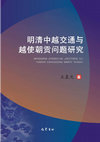
巴蜀書社, 2017
明清时期中越往來密切,考察兩國传统交通與越南使者北上沿途情形,不僅有助於理解中越地緣變遷形勢,更可窺見使節詩文中呈現的各種圖景。為彌補這一研究疏漏,本文擬對此進行研究。全文分上下兩編,上編三章專... more 明清时期中越往來密切,考察兩國传统交通與越南使者北上沿途情形,不僅有助於理解中越地緣變遷形勢,更可窺見使節詩文中呈現的各種圖景。為彌補這一研究疏漏,本文擬對此進行研究。全文分上下兩編,上編三章專論中越交通邊防,下編三章專論越使北上問題,實欲繼景范默深之志,鑒於往事以資時政。
本文前三章梳理廣東、雲南、廣西三省沿邊州縣往越南交通孔道,考察明清兩朝實際通行狀況,并論述陸道、水道盛衰緣由,統覽中越邊境交通變遷、軍事防備、延邊走私、經略維護等事宜。由於傳統研究往往誇大具體交通形勢,或囿於史料所限多加歪曲、疏漏,本文綜合晚近史地研究成果詳加分析,查缺補遺,去偽存真,并繪製地圖,雖以明清兩朝為時限,實則輻射漢唐以來地志,闡幽發微,以考中越孔道興廢歷史規律。
本文後三章主要藉助新出史料《越南漢文燕行文獻集成》與越使北上沿途各县方志等史料對明清越使北上貢道及朝覲路途細節進行研究,雖名為史地分析,實則兼顧越南使節政治意識之考察,揭示其創作意涵,更對往來貿易、挾帶私貨、吟詠應答、水行祭祀等問題進行梳理,從而分析使程行經地點、路線的取擇標準,更得以對明清社會情形、人物風貌、地理環境等展開考察,最終擺脫傳統地域性研究的狹隘思維,揭橥新史料的價值。其中末章專論明清越使入京路程,以阮氏《奉使燕京總歌並日記》為底本,以其餘筆記及傳統文獻對該文作注的手法進行寫作,分為廣西、湖南、湖北與江西、安徽與江蘇、山東、直隸六段進行敘述,并將《燕軺日程》長圖所繪塘、汛分佈整理列出,插於正文之中,以資參考。
China and Vietnam had a close relationship During Ming and Qing Dynasty, the traditional transport line and the route for Vietnam ambassadors to Beijing are important issues, they are related to the analysis of geopolitical issues between two countries, and are helpful to the study of ambassadors’ political thought as well as communication transition .This paper is dedicated to fill in the vacancy of the research.
In previous three sections of this thesis, the article tries to discover the reason of Prosperity and decline in land transportation as well as water transportation by analysis of the adjacent areas with Vietnam in Guangdong, Yunnan and Guangxi and of the actual traffic conditions between them during Ming and Qing Dynasty .Since traditional research often exaggerated the specific traffic situation, omitted or distorted the truth because of lack of historical materials ,this article seeks to synthesize the findings in history and geography , rectify the mistakes and analyze the specific conditions in detail to make maps ,thus I wish to inspect the traffic transition in a whole. It seems that this title is restricted to Ming and Qing Dynasty; actually I have also discussed the geography from Han Dynasty, Tang Dynasty to Qing Dynasty, talked about the details and obscure historical materials and finally explained the historical law in the prosperity and decline of traffic between two countries.
The following three chapters make full use of the latest historical materials such as Literature of Vietnam Diplomatic Envoys and the chorography of different places through which Vietnam ambassadors passed, Study the route for Vietnam ambassadors to Beijing and the details in their travelling .Although the title is limited to analysis of historical geography, it actually considers the political consciousness in their writing. This thesis also uncovers the thought in their works, talks about the issues such as commercial intercourse, smuggling, water sacrifice in order to analyze the choice criteria about the site and route in their journey. It reveals the value of new historical materials via investigating the environment of thought, society and geography and getting rid of the narrow mind in traditional study. The last chapter particularly examines the route Vietnam ambassadors chose in Ming and Qing Dynasty. In this chapter, the author comments on this thesis by other notes and traditional documents based on poetry of ambassadors to Beijing .It can be divided into 6 parts, namely, Guangxi, Hunan, Hubei and Jiangxi, Anhui and Jiangsu, Shandong, Zhili .According to this, the author arranges every post office and station in the map of the book, lists them in the end to help readers understand the route of ambassadors.
Papers by Wang Chen Guang 王晨光
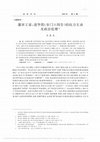
史學月刊, 2023
自戰國以降,學者寄希望於建立政治倫理學說以實現權力的制衡,慣性代入減省刑罰、施行德治、以民為本的仁君敘事疏釋先秦文獻,由此嚴重遮蔽了權力負責的基本邏輯。 通過重審清華簡《皇門》與《四告·滿告》,... more 自戰國以降,學者寄希望於建立政治倫理學說以實現權力的制衡,慣性代入減省刑罰、施行德治、以民為本的仁君敘事疏釋先秦文獻,由此嚴重遮蔽了權力負責的基本邏輯。 通過重審清華簡《皇門》與《四告·滿告》,可知西周政治倫理基於周王對「大門宗子勢臣」——即藩屏勢力集團的維護。 一方面,型、德、祀等表述,實質是周王訴求宗子守常、型范祖考、勤恤王邦。 另一方面冊封、主祭、共祀、昭穆制等設計,也維繫藩屏系統內各分族間的軍事互助紐帶。 周王與宗子處於利益共生的牽制關係。 故該類文獻屬於宗法系統對內的籠絡話語,並非集權形態下君民關係或君主內在道德的議題。 當藩屏模式被郡縣制取代,“民”的主體由率族藩屏的宗子降格為單向被動徵調的編戶齊民,導致權力雙向交互關係失衡,才發生諸子改造概念內涵,試圖通過製造政治倫理抑制王權獨大。Abstract: After the Warring States period, scholars hoped to establish a political ethics theory to achieve a balance of power. Due to the scholars' habit of using rhetoric such as reducing punishments, implementing virtuous governance, and loving the people like children to interpret pre-Qin literature, the basic logic of power being accountable to the people was seriously neglected. By comparing the Qinghua Bamboo Slips' “Huang Men” and “Si Gao,” it can be found that the political ethics of the Western Zhou Dynasty mainly focused on the maintenance of the core clan by the Zhou king. On the one hand, expressions such as "xing" (punishment), "de" (virtue), and "si" (sacrifice) were the Zhou king's appeals to the branch clans to continuously pledge loyalty and defend the royal family. On the other hand, presiding over sacrifices and participating in sacrifices also strengthened the military support alliance among the participants. The Zhou king and the sons of the royal family had common interests and mutually restrained each other. Therefore, this literature is not a topic where intellectuals in a centralized form call for monarchs to reform or strengthen morality unilaterally. When this structure was replaced by the county system, the subject of "min" changed from clan leaders to passive civilians who were unilaterally mobilized for resources, leading to an imbalance of power. This led intellectuals to reshape concepts and attempt to suppress the dominance of the monarchy with ideas.
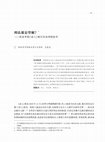
簡帛研究, 2021
通過對比《成人》與此前刊布的清華簡可知,多數先秦文献中出現的“型”應釋作典範,絶非刑罰之“刑”。《成人》絶非法制史文獻,全文呈現宗法制下以先王爲典範的觀念。“型”最初源於血緣分封制需要通過宗子祭... more 通過對比《成人》與此前刊布的清華簡可知,多數先秦文献中出現的“型”應釋作典範,絶非刑罰之“刑”。《成人》絶非法制史文獻,全文呈現宗法制下以先王爲典範的觀念。“型”最初源於血緣分封制需要通過宗子祭先王序昭穆來維繫互助互恤的宗法紐帶,共同進行繁雜而虔敬的祭祀得以强化凝聚力與既有統治秩序,這便是“型”與“祀”“常”“德”“先人”在古典書寫中經常同時出現的原因。簡文中“民”的失型也專指在王廷供職的封建主發生的離心離德。故崇古、常德與不易的施政理念乃基於宗法制結構而産生。By comparing Cheng Ren with the previously published Tsinghua Bamboo Slips, we can find that the Xing appearing in most Tsinghua Bamboo Slips should be interpreted as a model, not a penalty. Cheng Ren is not a literature about the history of the legal system. Its content is mainly about the sacrifices of ancestors in the feudal times. The Xing originated from blood politics and sacrifice activities, and its core was to establish alliance relationships with each other. When members of the family are sacrificed together, their relationship to protect each other is stronger, which can also repeatedly determine the relationship between their rule and being ruled. This is why the words Xing and sacrifice, virtue, and ancestors often happen simultaneously in classical literature. Min in the literature specifically refers to those feudal masters who served in the royal family. The literature calls for vigilance against their rebellious tendencies.

人文論叢, 2021
族邑自治時期的社會規範構成儒家思想的基礎。宗法共同體內部裁斷維護血緣組織穩定,家國同構式的君主訴求主觀進行德性審查、中庸調解、差異裁斷。而法治所訴求的觀念,根本基於普遍授田制後地方宗族向中央政權... more 族邑自治時期的社會規範構成儒家思想的基礎。宗法共同體內部裁斷維護血緣組織穩定,家國同構式的君主訴求主觀進行德性審查、中庸調解、差異裁斷。而法治所訴求的觀念,根本基於普遍授田制後地方宗族向中央政權的治權讓渡。在建立起郡縣層級政區後,統一的中央行政需要在轄域範圍內按照行文法制定標準的規範執行。相應的文教也轉為追求可計量、可控制、合乎邏輯與普遍適用的理性法則,尤其要基層行政排除主觀因素,並通過科層制與成文法管控個體。秦以降由於國家自身治理能力受限,不得不相容兩種文教,而同時智識群體拒斥對既行政制的正視,導致了長期延續的治教分離。The concept we call ‘Confucianism’ originated from the social norms formed during the period of clan-euptial autonomy and the rules of internal adjudication within the patriarchal community based on blood ties, which sought to maintain the stability of the ethical organization of the clan and to pursue a virtuous monarch with a unified family and state system of subjective balance, neutral coordination, and differential adjudication. The new doctrine of the rule of law had its origin in the transfer of power from the local clans to the central authorities after the establishment of the new hierarchical administrative districts, where a unified central administration was required to implement standard norms according to statutory law throughout the jurisdiction. The corresponding doctrine was transformed into the pursuit of measurable, controllable, logical and universally applicable rational means, especially at the grassroots level, where the administration eliminated subjectivity and controlled the individual through hierarchy and statute law. The empire's limited capacity to accommodate the two religions, as well as the intellectual community's refusal to confront the prevailing state of affairs, led to the perpetuation of the separation of church and state.

南大法學, 2021
“令”上升為固定執行的“律”是一個歷史過程,同時也是中央重組自治性封建族邑聚落,建立分工官僚管理體制、調配人力資源及規範制令的強效國家演生史。朱騰教授的論文為重新解釋清華簡《子產》提供了契機,借... more “令”上升為固定執行的“律”是一個歷史過程,同時也是中央重組自治性封建族邑聚落,建立分工官僚管理體制、調配人力資源及規範制令的強效國家演生史。朱騰教授的論文為重新解釋清華簡《子產》提供了契機,借此可以擺脫“德刑並重”等儒家慣性思維,重新認識《子產》簡所提供關於“令”伴隨著集權行政模式興起的重要思想史料,由此也可完善朱騰關於戰國令制的敘述。《子產》的內核正是建立配合戰國時期高強度動員令的意識形態,旨在打破分散的族治自保,調動人力資源固防,形成君民上下協同的機動兵力。《左傳》中的子產和戰國中後期《子產》簡所處理的問題,就是地方宗法分封貴族向集權型君主的治權轉移。The birth of the ritsuryo system is a historical process, which includes the autonomous reconstruction of the feudal settlement by the central authority, the establishment of a division of bureaucratic management system, and the allocation of human resources as well as the formulation of standardized laws and other links. The Zichan chapter of Tsinghua bamboo slips provides important ideological and historical materials about the early rise of the rule-based state. It shares a lot of ideas with Guanzi of the same era. It tries to establish the ideology that matches the high-intensity mobilization order during the Warring States period, aiming to break the decentralized ethnic self-protection system, thus mobilizing human resources to consolidate defense and forming the monarch-people system of strong cohesion. The problem Zichan in Zuozhuan and Zichan in the middle and late Warring States period dealt with is actually the transfer of power from the feudal aristocracy to the centralized monarchy.

近代中國, 2021
武漢作為港口型城市,經濟地位取決於川湘、上海的物流通道。北伐軍接管武漢後,有產者向外遷移遵循經濟避險的基本規律,當國民政府不能提供安全的營業環境、穩定的匯率、暢通的物流,資本就會加速外逃。從國民... more 武漢作為港口型城市,經濟地位取決於川湘、上海的物流通道。北伐軍接管武漢後,有產者向外遷移遵循經濟避險的基本規律,當國民政府不能提供安全的營業環境、穩定的匯率、暢通的物流,資本就會加速外逃。從國民革命軍北伐至武昌圍城戰,均依賴於有產者的資金支持。但戰後卻無法解決軍費超額支出與資產穩定發展的比重問題,越是採取巨細靡遺的管控與徵稅,越需汲取更多的經費支撐。然而激進的革命話語卻導致商民協會和工會迅速膨脹,武漢原有的宗法產業結構與地緣構成的幫口經濟,被迫捲入激進的浪潮。伴隨產業鏈的斷裂,恐慌的有產者基於長期運行的資本網路迅速逃離,使武漢陷入絕境。As a port city, Wuhan's economic status depends on the logistic access to Sichuan, Hunan and Shanghai. When the national government fails to provide a safe business environment, a stable exchange rate and smooth logistics, capital flight will accelerate. The Northern Expedition of the National Revolutionary Army up to the Siege of Wuchang depended on the financial support of the bourgeoisies. However, the post-war problem of military spending and the proportion of the bourgeoisie cannot be solved, and the more control and taxation is applied, the more funding is needed to support it. However, the radical revolutionary rhetoric led to a rapid expansion of trade unions, and Wuhan's original patriarchal industries and geo-constituted gangster economic structure were forced into a wave of radicalization. With the break in the chain, panicked bourgeoisies quickly fled based on long-running capital networks, leaving Wuhan in limbo.
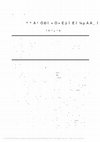
宗教學研究, 2020
陝西定邊郝灘出土壁畫與此前陝西靖邊、陝西西安、山東微山、內蒙古鄂托克旗、江蘇徐州的七塊不同區域畫像存在密切聯繫。從繪製格套與畫師意圖切入,可知郝灘壁畫的母題符合漢代宴樂繪法的基本格套,注重通過“... more 陝西定邊郝灘出土壁畫與此前陝西靖邊、陝西西安、山東微山、內蒙古鄂托克旗、江蘇徐州的七塊不同區域畫像存在密切聯繫。從繪製格套與畫師意圖切入,可知郝灘壁畫的母題符合漢代宴樂繪法的基本格套,注重通過“圍觀”繪法來凸顯畫面主體。定邊、靖邊壁畫中太一等神非為圖像強調的主體,而屬於“邊緣與陪襯”,其作為迎接屍解登仙的核心神祇出現于宴樂格套中“圍觀”的主位。漢代宴樂圖與升仙圖的繪法、佈局均存在沿襲。以往漢代壁畫中被研究者判定為“宴樂圖”主題的圖像應為“升仙圖”,借此可證兩漢時期本土宗教觀念到宗教形象的逐步型塑過程。
Han Dynasty banquet mural and immortal mural shares the same drawing techniques. Through Haotan’s mural painting drawing routines and the artist's intention, we can find that the proterotype of the mural in line with the Han Dynasty banquet painting. That is, through the circusee painting method to highlight the main part. The specific drawing techniques include four points: shaping the space surrounded by the onlooker, using fine and rough different paintings to distinguish between performers and onlookers, painting attendants to show the identity of the onlookers, drawing two-thirds of the face to strengthen the circusee. These circusee proterotypes show that the Taiyi god in Dingbian & Jingbian murals is not the main body of the image, whereas belong to the edge and foil. Taiyi as core of gods which meets the reincarnated soul to help departed ascending immortal. Artist take the double layer and imbalance graphic design, which also in line with the banquet mural painting routines.
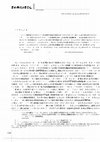
華中科技大學學報, 2019
傳統關於“禮法”的論述構建了“法律儒家化”線性史觀,遮罩了對治權結構的分析。禮法的實質在於古代國家財政效能無力負擔對個體的全面管控,故讓渡部分隱性治權給父家長。而隨清後期人口增殖與流動加劇、經濟... more 傳統關於“禮法”的論述構建了“法律儒家化”線性史觀,遮罩了對治權結構的分析。禮法的實質在於古代國家財政效能無力負擔對個體的全面管控,故讓渡部分隱性治權給父家長。而隨清後期人口增殖與流動加劇、經濟糾紛等基層司法冗雜化,基於血緣關係所建立的仲裁權威與互保機制逐漸式微,個體權利衝突訴求外部獨立司法權力予以客觀裁斷。近代轉型本質也訴求直接訓練國民並管控個人。故新型管控模式不再依靠血緣家族維持熟人化、息訟式管理,由此衝擊原身份制分層自治的社會結構,古典禮法危機的根源即在於是否應接受新型人口管控與治理模式的策略分歧。
The traditional Ritual Law narrative constructed Confucianization of Law linear historical perspective and ignored the analysis on governance right structure. The essence of Ritual Law is that fiscal efficiency of ancient state was unable to undertake the comprehensive control on individuals,and therefore,some implicit authorities were transited to father parent. With the increased population reproduction and mobility in the late Qing dynasty,and jumbled grass roots justice such as economic disputes,the arbitration authority and mutual insurance mechanism established based on blood relation were declined gradually. The individual right conflicts appealed the external independent judicial power to present the objective judgment.At the same time, the essence of the transformation in modern times also appealed to directly train national citizens and control individuals.Therefore,new type management and control mode no longer maintains acquaintance and litigation quelling management relying on blood family. New type destroyed the hierarchical and autonomous social structure and the original identity system. The key to the crisis is about whether accept the strategy divergence of new type population management and governance mode.
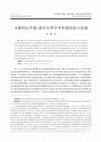
文史哲, 2019
1949年後臺海冷戰形勢使得香港成為爭取知識份子的核心區域,臺灣當局一方面對知識份子進行經濟接援,另一方面潛移默化思想認同,使其達成不自知的隱性共謀,文教被異化為政治形態的附屬物。遷台後的傳統文... more 1949年後臺海冷戰形勢使得香港成為爭取知識份子的核心區域,臺灣當局一方面對知識份子進行經濟接援,另一方面潛移默化思想認同,使其達成不自知的隱性共謀,文教被異化為政治形態的附屬物。遷台後的傳統文化學者雖與政黨處於不同目的,但在冷戰格局下,學術研究仍難以擺脫權力的塑型,政治倫理化的努力則被轉變為權力一元化的理論資源乃至控制民眾思想的工具。與此同時,蔣政府與美國教會勢力相互勾結,前者運用教會勢力進行反共宣傳,後者則控制台灣文教系統進行文化殖民。教會、政黨與學校亦形成共謀體系。而學術內部的義理考據之辨,也潛藏著學者的身份差異。受特權庇護的知識份子專注于文獻考索,在政治與社會亂象前選擇失語,而徐複觀等反抗者則被排擠到權力的邊緣。
After 1949, the Cold War situation made Hong Kong became a shelter for intellectuals. The KMT and the CPC launched propaganda and cultural warfare. On the one hand, the Taiwan authorities have carried out economic assistance to intellectuals, on the other hand, exerted a subtle influence on intellectuals in order to make them reach an impalpable collaboration. Although traditional cultural scholars and political parties which migrated to Taiwan were at different ends. However, under the pattern of the Cold War, academic research is still difficult to get rid of the shaping of power. The efforts of promoting political ethics were transformed into the united front theoretical resources and control tools for people's thinking. At the same time, the Chiang Kai-shek reached a collusion with the American church forces. The former use church forces to conduct anti-communist propaganda, and the latter control the Taiwan's culture and education system for colonization. Finally, Church, political parties and schools formed a conspiracy system. Beyond that, the internal academic debate of textual research & argumentation also implies the separate identity between scholars. The privileged intellectuals were concentrated on literature examinations, choosing to escape political and social chaos, and the rebels like Xu Fuguan are marginalized to the edge of power.
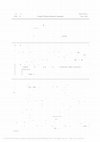
中國歷史地理論叢, 2018
先秦時期,對湘黔地區的控制是以河道為軸心建立戰略據點,繼而逐漸向水道上源與山脈腹地滲透,武陵山脈分水嶺導致烏江、沅水形成兩大分離的政治空間,僅憑藉長江溝通,通過重審古地圖畫工的意圖可理解施政實情... more 先秦時期,對湘黔地區的控制是以河道為軸心建立戰略據點,繼而逐漸向水道上源與山脈腹地滲透,武陵山脈分水嶺導致烏江、沅水形成兩大分離的政治空間,僅憑藉長江溝通,通過重審古地圖畫工的意圖可理解施政實情,故司馬錯絕無可能由烏江轉酉水前往沅水流域所謂的楚黔中,建立在此行軍道路基礎上的楚黔中臨沅說或沅陵說不能成立,而“更始水道”純屬酈道元主觀造作的謬誤。楚“黔中郡”治位於烏江彭水,西元前280年被司馬錯所占。楚在洞庭以南沅水及支流建有十五個邑點,主要在於扼守濮、越等族東出水道,重心位於沅陵。西元前277年江南十五邑曾被蜀守張若攻佔,並連同司馬錯所占烏江組建臨時大戰區“黔中郡”,然而次年十五邑便被楚奪回,由此導致秦楚史書產生不同的史學敘事,最終導致《史記》秦本紀與楚世家記載差異。直至西元前222年,王翦才清除沅水流域楚勢力建立秦“洞庭郡”,十五邑始轉化為裡耶簡所見洞庭轄縣,其目的仍在於防控武陵山脈腹地的敵對族群。
Up to Qin during Warring States period, the control of Xiang and Qian regions was that built strategic position with river course as axis, and then gradually infiltrated into the source of water channel and into mountains hinterland. Wuling mountain watershed led Wujiang river and Yuan river to form two separate political space, connected only by the Yangtze river. Reviewing ancient maps painters’ intent could understand the truth of the policy. So, it was impossible for Cuo Sima to move from Wujiang river to Qiu river to go to the so-called the center of Chu Qianzhong. Lin-Yuan Theory or Yuan-Ling Theory based on this march road cannot be established, and the “Geng Shi water channel” is purely subjective fallacy made by Daoyuan Li. “Qianzhong prefecture” of Chu was located in Pengshui of Wujiang river, which was occupied by Cuo Sima in 280 BC. Chu had 15 cities in Yuan river region and its tributaries, where was the south of Dongting, and that was to prevent Pu, Yue and other clans to go out through the east waterway, and the core was in Yuanling. In 277 BC, 15 cities in the south of the Yangtze were occupied by Ruo Zhang, who was the guard of Shu, and he built the “Qianzhong prefecture” in temporary war zone together with Wu river which was occupied by Cuo Sima. However, 15 cities were retaken by the state of Chu in the following year, resulting in different historical narratives in the history of Qin and Chu as well as the difference between Qinbenji of Shih Chi and Chushijia. It was not until 222 BC that Jian Wang made an effort to remove the Chu power in the Yuan river region and establish the "Dongting prefecture" in Qin. 15 cities started to be transformed into Dongting prefecture jurisdiction areas that Yejian Li saw, and that was still to control the rival clas in the heart of the Wuling mountains.
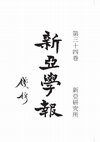
新亞學報, 2017
徐復觀的新儒家身份常使人忽視其思想史撰述的意圖。上世紀六七十年代,徐復觀同考據派和形上學的學者發生或明或暗的衝突。通過學術史鉤沉,可以發現衝突背後絕非僅是治學趣向的差異,而暗含著如何回歸以經史為... more 徐復觀的新儒家身份常使人忽視其思想史撰述的意圖。上世紀六七十年代,徐復觀同考據派和形上學的學者發生或明或暗的衝突。通過學術史鉤沉,可以發現衝突背後絕非僅是治學趣向的差異,而暗含著如何回歸以經史為主體的中國古典學思考。其對魯實先、屈萬里、錢穆等人的批判主要針對客觀化、精微化的史學研究漸趨於「過度推演」的弊症,而其對唐君毅、牟宗三、熊十力等人的批判則主要針對形上學式的經典改造及詮釋疏缺。由此,徐復觀接納現代史學成果,通過歷史語境學的方式呈現經學史,強調思想家對所處時空的憂患,其目的是要回歸「經史-經世」為主體的中國古典學教義。
Xu Fuguan's New Confucian identity often makes people ignore the intention of his writing. In the1960s and 1970s, Xu Fuguan collided with the scholars of the textual criticism and philosophy. Through academic history, it can be found that the conflict is not only the difference between scholarship, but implies how to return to the history as the mainstay of Chinese classical thinking. The criticism of Lu Shixian, Qu Wanli, Qian Mu and others is mainly aimed at the objective and subtle historical research gradually becoming " over-generalizing" and denying the cultural values. His criticism of Tang Junyi, Mou Zongsan, Xiong Shili, is mainly for the philosophy style of re-interpretation of Chinese classics and the lack of interpretation. Thus, Xu Fuguan accepted the achievements of modern historiography, presenting the history of Confucian classics through the method of historical contextualism, and emphasized the intellectuals』sense of predicament. His purpose was to return to the statecraft orientation of Chinese classics.

中國歷史地理論叢, 2015
孔子與葉公關于當父親偷竊別人的羊,兒子是否應該包庇父親的論辯,並不是一個倫理選擇的話題,而屬於春秋後期北方姬姓諸侯國和南部楚國不同政制體制的對立。這個問題意味著中國集權的政治形態恰恰不是中原內部... more 孔子與葉公關于當父親偷竊別人的羊,兒子是否應該包庇父親的論辯,並不是一個倫理選擇的話題,而屬於春秋後期北方姬姓諸侯國和南部楚國不同政制體制的對立。這個問題意味著中國集權的政治形態恰恰不是中原內部產生的,而來自於周邊被視為“蠻夷”的國家。所以,這個看似屬於哲學的話題,必須放置在具體的歷史語境中才能夠得到正確的考察。本文考證這場論辯發生的具體的時間和空間,並且討論了楚國在軍事作戰中戰略。通過細緻的分析,我們可以發現,葉公是楚國派遣在同姬姓諸侯國交戰的邊疆,並且他屯戍時主要面臨的是對蔡國舊有貴族的治理問題。春秋後期的楚國迫切需要通過縣制對佔領區進行集權式管轄,而這則與原有封建制要求族群享有內部的自治權發生矛盾,“親親相隱”就是兩種體制在司法領域對峙的集中凸顯。
The debate between Confucius and Duke Ye about whether a son should harbor his father when his father steals another man's sheep is not a topic of ethical choice, but belongs to the confrontation between the different political systems of the northern Ji vassal states and the southern Chu state in the late Spring and Autumn period. This issue implies that the political form of centralized power in China did not come from within the Central Plains, but from the neighboring countries that were considered barbarians. Therefore, this seemingly philosophical topic must be placed in a specific historical context in order to be properly examined. This paper examines the specific time and space in which this debate took place and discusses Chu's strategy in military combat. Through careful analysis, we can find that Lord Ye was sent by the state of Chu to fight on the frontier with the Ji vassal states, and that he was mainly faced with the problem of governing the old nobles of Cai when he was in garrison. In the late Spring and Autumn period, the imperative need for Chu to exercise centralized control over the occupied areas through the county system contradicted the original feudal system's demand for internal autonomy of the communities, which was highlighted by the confrontation between the two systems in the judicial field.
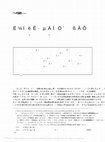
天府新論, 2016
現代史學的兩項基礎,即史料考證編纂方法與歷史因果解釋,已備受後現代史學質疑。福柯的譜系學與斯金納、徐複觀的思想史在這種語境下興起,其均對歷史穩定結構、觀念與敘事的連貫性提出質疑。三者核心手法主要... more 現代史學的兩項基礎,即史料考證編纂方法與歷史因果解釋,已備受後現代史學質疑。福柯的譜系學與斯金納、徐複觀的思想史在這種語境下興起,其均對歷史穩定結構、觀念與敘事的連貫性提出質疑。三者核心手法主要有兩點:首先,將權力和政治引入思想分析,注重討論具體時空中話語、政治、行動的關係;其次,將以往連續性學術史敘述解構為不同情境下的政治行動。由此其呈現概念本身的斷裂性,以古代的知識作為現代的參照,挖掘斷裂的歷史面來批判現實。但是福柯與斯金納、徐複觀仍有區分,福柯注重權力的策略、網路、機制,而後兩者的思想史則繼承現代史學的史料分析手法,對作者主體性懷有敬重,且徐複觀的經史之學更有助於紓解後現代的困境。
The two basic foundations of modern history, that is, the historiography and historical causality have been questioned by postmodern history. Foucault's genealogy and Skinner, Xu Fuguan's intellectual history appeared in this context. Three scholars questioned the structure of historical stability as well as the coherence of ideas and narratives. There are two main points in the core approach: first, they introduce power and politics into ideological analysis, focusing on the discussion of specific space-time discourse, politics, and action; Secondly, they deconstructed the academic history of successive academic history into political action in different contexts. In this way, they present the fragmentation of the concept itself, with the ancient knowledge as a modern reference, mining the history of the fault to criticize the reality. However, Foucault and Skinner, Xu Fuguan still have a distinction, Foucault focus on power strategy, While the other two scholars inherited the historical analysis of modern history, and respected for subjectivity of the author. Finally, Xu Fuguan 's research helps to alleviate the post-modern dilemma.
孔子研究, 2016
徐復觀與熊十力的分歧體現為兩種不同的“疏釋”。熊十力通過詮釋經典所建構的心學體系並未回應現代實證史學的詰難,仍是“古代的疏釋”。而徐復觀“現代的疏釋”則通過歷史語境學式思想史的方法,在現代學術範... more 徐復觀與熊十力的分歧體現為兩種不同的“疏釋”。熊十力通過詮釋經典所建構的心學體系並未回應現代實證史學的詰難,仍是“古代的疏釋”。而徐復觀“現代的疏釋”則通過歷史語境學式思想史的方法,在現代學術範式中重彰經史系統,其不僅回應哲學的批判,更規避了考據學的疏缺。徐復觀的思想史有效地紓解了近現代經學危機,維持了儒學精神在庶民社會繼續傳播的可能。
The difference between Xu Fuguan and Xiong Shili represents the conflict of hermeneutic attitude. The theoretic system built by Xiong cannot responds to the question raised by modern objectivity history. Whereas, Xu's method of intellectual history is similar to historical contextualism, which not only responds to the blame and criticism put forward by the philosopher, but also prevents the oversights of textology. His intellectual history shows the meaning of the classics & history system as well as resolves the crisis of modern classics effectively. Finally he maintains the connection of spirit of confucianism and general public.
人文論叢, 2016
章學誠對明遺民的著史傳統加以改造,一方面彰顯“切於人事”,另一方面削減了遺民色彩與謾駡空論的風氣,由此構建的“浙東學術”譜系並非調和朱陸,而是批判考據派預設經典權威自足所進行的封閉式研究。他要求... more 章學誠對明遺民的著史傳統加以改造,一方面彰顯“切於人事”,另一方面削減了遺民色彩與謾駡空論的風氣,由此構建的“浙東學術”譜系並非調和朱陸,而是批判考據派預設經典權威自足所進行的封閉式研究。他要求通過思想文本創作的時空場域逆推寫作者書寫意圖,提倡切於人事,經史互彰,並形成了一套釋經學方法,對當下經學研究具有借鑒意義。
Zhang Xuecheng modified the tradition of adherent of Ming Dynasty. On the one hand, he claimed that scholars should “focus on realistic status”, on the other hand, he criticised the academic atmosphere of abuse current regime, therefore, he build the concept of “East Zhejiang School”. This fictional lineage was not intended to reconcile Zhu Xi and Lu Xiangshan, but criticised the textual scholars which approved the scripture authority are self-sufficient. He asked through the field of space and time of text creation to reveal writers writing intention, and formed a set of intellectual history research methods.
福建師範大學學報, 2016
章學誠面臨的危機可概括為經典解釋系統的封閉性。由於考據派學者預設了經典權威與教義自足,故經典研究漸趨僵滯,缺乏對現實政制的借鑒。由此,章學誠訴求一種文本與制度的互動視域,並推闡出一套歷史語境學式... more 章學誠面臨的危機可概括為經典解釋系統的封閉性。由於考據派學者預設了經典權威與教義自足,故經典研究漸趨僵滯,缺乏對現實政制的借鑒。由此,章學誠訴求一種文本與制度的互動視域,並推闡出一套歷史語境學式的釋經學方法,以此為契機重塑經典的價值。這有助於紓解近代歷史實證主義所引發的經學危機,對於重返經史之學具有借鑒價值。
Zhang Xue Cheng faced a crisis that can be summarized as a closed system of interpretation. The hermeneutic scholars were unable to cope with the political crisis, on account of the traditional explanation presupposed the classic is undoubtedly authoritative. Thus, zhang Xue-cheng appealed a horizon of an interactive system of the text and the political system. Zhang also pushed a research method of History of Ideas which tends to review theories in historical context. Through this way he wanted to reshape the value of classic. This would be a very practical value in solving the problem of Chinese classical crisis.
東亞人文, 2015
《越南漢文燕行文獻集成(越南所藏編)》是明清時期越南貢使前往北京朝貢路程中的詩文作品,詩文展現了越南貢使以域外身份對中原風土人物進行的審視。詩文除卻遣詞章法的文學賞析功能外,更為當時中越之間政治... more 《越南漢文燕行文獻集成(越南所藏編)》是明清時期越南貢使前往北京朝貢路程中的詩文作品,詩文展現了越南貢使以域外身份對中原風土人物進行的審視。詩文除卻遣詞章法的文學賞析功能外,更為當時中越之間政治交流、文化互動的第一手史料,因此不僅帶來思想的衝擊性,又展開一幅東南亞漢文化圈交流的真實圖景。
During the Ming and Qing Dynasties, tributary which from Vietnam to Beijing always writing poetry in their journey. Literature of Vietnam Diplomatic Envoys is a new historical data, which shows Vietnam tributary examine local character with a extraterritorial status. Poetry in addition to a rhetoric with literature, especially is a firsthand historical data which shows Sino- Vietnam political exchanges and cultural interaction, thus brings not only the impact of thought, but also the true fragment of Southeast Asian exchanges.
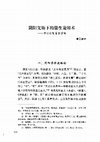
陽明學刊, 2015
晚近古史辨派希望通過追溯“陰陽”的淵源來解釋今古文差異,然而卻架空思想背景將儒生與方士混淆。實際上,陰陽學並非王官學“為天下裂”的分支,而是與之並列的思想系統。而鄒衍將政治訓誡與制度理想隱藏在陰... more 晚近古史辨派希望通過追溯“陰陽”的淵源來解釋今古文差異,然而卻架空思想背景將儒生與方士混淆。實際上,陰陽學並非王官學“為天下裂”的分支,而是與之並列的思想系統。而鄒衍將政治訓誡與制度理想隱藏在陰陽五行的文飾之下,故其宗旨乃儒家,而非陰陽家祖師。漢儒則延續鄒衍論證修辭方法,表面雖談陰陽,實則本于儒家大義設陰陽五行名相以推闡其說,根本則在討論政制改革,依據其政治主張,又可分為複封建、張郡縣兩派。通過對張蒼、賈誼、公孫臣、新垣平、趙綰、王臧、董仲舒等人的論點考察,進而揭示漢儒關於政制變革的微言大義。
Modern History researchers hope to explain the difference in terms of the Han Dynasty literature through retrospective the theory of Yin-Yang, however, they neglect the ideological background, and confused the Confucian scholars with diviner. In fact, the theory of Yin-Yang is not a faction of Western Zhou Dynasty government's political academic, on the contrary, he thought the system was juxtaposed with the government's academic. Zou Yan hidden the admonish and the ideal of political system under the Yin-Yang represention, so his Speech should be a part of Confucian, rather than a Divination Patriarch. The Han Dynasty, Confucian scholars always continue this rhetoric founded by Zou Yan, they talk about Yin-Yang on the surface, but in fact it is based on the Confucian doctrine, and according to their political views , they are divided into two main factions :the prefectures and counties system,the enfeoffment system. By investigate some Western Han Dynasty Confucian rhetoric, the paper reveals the Western Han Dynasty's esoteric political argumentation skills.
西安石油大學學報, 2013
西漢初期學術具有強烈的政治意識,在五行與陰陽思想之後,皆蘊含著對封建制的批評與重塑。相對而言,《周禮》代表的傳統儒學亦暗含諸侯各定其制,王需對四方諸侯形勢地利觀察以制定具體政策的思想。Weste... more 西漢初期學術具有強烈的政治意識,在五行與陰陽思想之後,皆蘊含著對封建制的批評與重塑。相對而言,《周禮》代表的傳統儒學亦暗含諸侯各定其制,王需對四方諸侯形勢地利觀察以制定具體政策的思想。Western Han Dynasty has a strong academic and political awareness .Among the WuXing and Yin Yang ideology , Therer contains a criticism of the feudal system and remodeling. Relatively speaking, ZhouLi is a representative of the traditional Confucianism which contains princes entered into the respective system, while the king is required to observe the situation on the different parts, so as to formulate specific policy ideas.
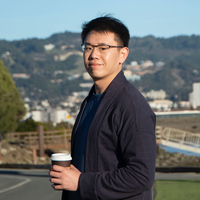






Uploads
Books by Wang Chen Guang 王晨光
本文前三章梳理廣東、雲南、廣西三省沿邊州縣往越南交通孔道,考察明清兩朝實際通行狀況,并論述陸道、水道盛衰緣由,統覽中越邊境交通變遷、軍事防備、延邊走私、經略維護等事宜。由於傳統研究往往誇大具體交通形勢,或囿於史料所限多加歪曲、疏漏,本文綜合晚近史地研究成果詳加分析,查缺補遺,去偽存真,并繪製地圖,雖以明清兩朝為時限,實則輻射漢唐以來地志,闡幽發微,以考中越孔道興廢歷史規律。
本文後三章主要藉助新出史料《越南漢文燕行文獻集成》與越使北上沿途各县方志等史料對明清越使北上貢道及朝覲路途細節進行研究,雖名為史地分析,實則兼顧越南使節政治意識之考察,揭示其創作意涵,更對往來貿易、挾帶私貨、吟詠應答、水行祭祀等問題進行梳理,從而分析使程行經地點、路線的取擇標準,更得以對明清社會情形、人物風貌、地理環境等展開考察,最終擺脫傳統地域性研究的狹隘思維,揭橥新史料的價值。其中末章專論明清越使入京路程,以阮氏《奉使燕京總歌並日記》為底本,以其餘筆記及傳統文獻對該文作注的手法進行寫作,分為廣西、湖南、湖北與江西、安徽與江蘇、山東、直隸六段進行敘述,并將《燕軺日程》長圖所繪塘、汛分佈整理列出,插於正文之中,以資參考。
China and Vietnam had a close relationship During Ming and Qing Dynasty, the traditional transport line and the route for Vietnam ambassadors to Beijing are important issues, they are related to the analysis of geopolitical issues between two countries, and are helpful to the study of ambassadors’ political thought as well as communication transition .This paper is dedicated to fill in the vacancy of the research.
In previous three sections of this thesis, the article tries to discover the reason of Prosperity and decline in land transportation as well as water transportation by analysis of the adjacent areas with Vietnam in Guangdong, Yunnan and Guangxi and of the actual traffic conditions between them during Ming and Qing Dynasty .Since traditional research often exaggerated the specific traffic situation, omitted or distorted the truth because of lack of historical materials ,this article seeks to synthesize the findings in history and geography , rectify the mistakes and analyze the specific conditions in detail to make maps ,thus I wish to inspect the traffic transition in a whole. It seems that this title is restricted to Ming and Qing Dynasty; actually I have also discussed the geography from Han Dynasty, Tang Dynasty to Qing Dynasty, talked about the details and obscure historical materials and finally explained the historical law in the prosperity and decline of traffic between two countries.
The following three chapters make full use of the latest historical materials such as Literature of Vietnam Diplomatic Envoys and the chorography of different places through which Vietnam ambassadors passed, Study the route for Vietnam ambassadors to Beijing and the details in their travelling .Although the title is limited to analysis of historical geography, it actually considers the political consciousness in their writing. This thesis also uncovers the thought in their works, talks about the issues such as commercial intercourse, smuggling, water sacrifice in order to analyze the choice criteria about the site and route in their journey. It reveals the value of new historical materials via investigating the environment of thought, society and geography and getting rid of the narrow mind in traditional study. The last chapter particularly examines the route Vietnam ambassadors chose in Ming and Qing Dynasty. In this chapter, the author comments on this thesis by other notes and traditional documents based on poetry of ambassadors to Beijing .It can be divided into 6 parts, namely, Guangxi, Hunan, Hubei and Jiangxi, Anhui and Jiangsu, Shandong, Zhili .According to this, the author arranges every post office and station in the map of the book, lists them in the end to help readers understand the route of ambassadors.
Papers by Wang Chen Guang 王晨光
Han Dynasty banquet mural and immortal mural shares the same drawing techniques. Through Haotan’s mural painting drawing routines and the artist's intention, we can find that the proterotype of the mural in line with the Han Dynasty banquet painting. That is, through the circusee painting method to highlight the main part. The specific drawing techniques include four points: shaping the space surrounded by the onlooker, using fine and rough different paintings to distinguish between performers and onlookers, painting attendants to show the identity of the onlookers, drawing two-thirds of the face to strengthen the circusee. These circusee proterotypes show that the Taiyi god in Dingbian & Jingbian murals is not the main body of the image, whereas belong to the edge and foil. Taiyi as core of gods which meets the reincarnated soul to help departed ascending immortal. Artist take the double layer and imbalance graphic design, which also in line with the banquet mural painting routines.
The traditional Ritual Law narrative constructed Confucianization of Law linear historical perspective and ignored the analysis on governance right structure. The essence of Ritual Law is that fiscal efficiency of ancient state was unable to undertake the comprehensive control on individuals,and therefore,some implicit authorities were transited to father parent. With the increased population reproduction and mobility in the late Qing dynasty,and jumbled grass roots justice such as economic disputes,the arbitration authority and mutual insurance mechanism established based on blood relation were declined gradually. The individual right conflicts appealed the external independent judicial power to present the objective judgment.At the same time, the essence of the transformation in modern times also appealed to directly train national citizens and control individuals.Therefore,new type management and control mode no longer maintains acquaintance and litigation quelling management relying on blood family. New type destroyed the hierarchical and autonomous social structure and the original identity system. The key to the crisis is about whether accept the strategy divergence of new type population management and governance mode.
After 1949, the Cold War situation made Hong Kong became a shelter for intellectuals. The KMT and the CPC launched propaganda and cultural warfare. On the one hand, the Taiwan authorities have carried out economic assistance to intellectuals, on the other hand, exerted a subtle influence on intellectuals in order to make them reach an impalpable collaboration. Although traditional cultural scholars and political parties which migrated to Taiwan were at different ends. However, under the pattern of the Cold War, academic research is still difficult to get rid of the shaping of power. The efforts of promoting political ethics were transformed into the united front theoretical resources and control tools for people's thinking. At the same time, the Chiang Kai-shek reached a collusion with the American church forces. The former use church forces to conduct anti-communist propaganda, and the latter control the Taiwan's culture and education system for colonization. Finally, Church, political parties and schools formed a conspiracy system. Beyond that, the internal academic debate of textual research & argumentation also implies the separate identity between scholars. The privileged intellectuals were concentrated on literature examinations, choosing to escape political and social chaos, and the rebels like Xu Fuguan are marginalized to the edge of power.
Up to Qin during Warring States period, the control of Xiang and Qian regions was that built strategic position with river course as axis, and then gradually infiltrated into the source of water channel and into mountains hinterland. Wuling mountain watershed led Wujiang river and Yuan river to form two separate political space, connected only by the Yangtze river. Reviewing ancient maps painters’ intent could understand the truth of the policy. So, it was impossible for Cuo Sima to move from Wujiang river to Qiu river to go to the so-called the center of Chu Qianzhong. Lin-Yuan Theory or Yuan-Ling Theory based on this march road cannot be established, and the “Geng Shi water channel” is purely subjective fallacy made by Daoyuan Li. “Qianzhong prefecture” of Chu was located in Pengshui of Wujiang river, which was occupied by Cuo Sima in 280 BC. Chu had 15 cities in Yuan river region and its tributaries, where was the south of Dongting, and that was to prevent Pu, Yue and other clans to go out through the east waterway, and the core was in Yuanling. In 277 BC, 15 cities in the south of the Yangtze were occupied by Ruo Zhang, who was the guard of Shu, and he built the “Qianzhong prefecture” in temporary war zone together with Wu river which was occupied by Cuo Sima. However, 15 cities were retaken by the state of Chu in the following year, resulting in different historical narratives in the history of Qin and Chu as well as the difference between Qinbenji of Shih Chi and Chushijia. It was not until 222 BC that Jian Wang made an effort to remove the Chu power in the Yuan river region and establish the "Dongting prefecture" in Qin. 15 cities started to be transformed into Dongting prefecture jurisdiction areas that Yejian Li saw, and that was still to control the rival clas in the heart of the Wuling mountains.
Xu Fuguan's New Confucian identity often makes people ignore the intention of his writing. In the1960s and 1970s, Xu Fuguan collided with the scholars of the textual criticism and philosophy. Through academic history, it can be found that the conflict is not only the difference between scholarship, but implies how to return to the history as the mainstay of Chinese classical thinking. The criticism of Lu Shixian, Qu Wanli, Qian Mu and others is mainly aimed at the objective and subtle historical research gradually becoming " over-generalizing" and denying the cultural values. His criticism of Tang Junyi, Mou Zongsan, Xiong Shili, is mainly for the philosophy style of re-interpretation of Chinese classics and the lack of interpretation. Thus, Xu Fuguan accepted the achievements of modern historiography, presenting the history of Confucian classics through the method of historical contextualism, and emphasized the intellectuals』sense of predicament. His purpose was to return to the statecraft orientation of Chinese classics.
The debate between Confucius and Duke Ye about whether a son should harbor his father when his father steals another man's sheep is not a topic of ethical choice, but belongs to the confrontation between the different political systems of the northern Ji vassal states and the southern Chu state in the late Spring and Autumn period. This issue implies that the political form of centralized power in China did not come from within the Central Plains, but from the neighboring countries that were considered barbarians. Therefore, this seemingly philosophical topic must be placed in a specific historical context in order to be properly examined. This paper examines the specific time and space in which this debate took place and discusses Chu's strategy in military combat. Through careful analysis, we can find that Lord Ye was sent by the state of Chu to fight on the frontier with the Ji vassal states, and that he was mainly faced with the problem of governing the old nobles of Cai when he was in garrison. In the late Spring and Autumn period, the imperative need for Chu to exercise centralized control over the occupied areas through the county system contradicted the original feudal system's demand for internal autonomy of the communities, which was highlighted by the confrontation between the two systems in the judicial field.
The two basic foundations of modern history, that is, the historiography and historical causality have been questioned by postmodern history. Foucault's genealogy and Skinner, Xu Fuguan's intellectual history appeared in this context. Three scholars questioned the structure of historical stability as well as the coherence of ideas and narratives. There are two main points in the core approach: first, they introduce power and politics into ideological analysis, focusing on the discussion of specific space-time discourse, politics, and action; Secondly, they deconstructed the academic history of successive academic history into political action in different contexts. In this way, they present the fragmentation of the concept itself, with the ancient knowledge as a modern reference, mining the history of the fault to criticize the reality. However, Foucault and Skinner, Xu Fuguan still have a distinction, Foucault focus on power strategy, While the other two scholars inherited the historical analysis of modern history, and respected for subjectivity of the author. Finally, Xu Fuguan 's research helps to alleviate the post-modern dilemma.
The difference between Xu Fuguan and Xiong Shili represents the conflict of hermeneutic attitude. The theoretic system built by Xiong cannot responds to the question raised by modern objectivity history. Whereas, Xu's method of intellectual history is similar to historical contextualism, which not only responds to the blame and criticism put forward by the philosopher, but also prevents the oversights of textology. His intellectual history shows the meaning of the classics & history system as well as resolves the crisis of modern classics effectively. Finally he maintains the connection of spirit of confucianism and general public.
Zhang Xuecheng modified the tradition of adherent of Ming Dynasty. On the one hand, he claimed that scholars should “focus on realistic status”, on the other hand, he criticised the academic atmosphere of abuse current regime, therefore, he build the concept of “East Zhejiang School”. This fictional lineage was not intended to reconcile Zhu Xi and Lu Xiangshan, but criticised the textual scholars which approved the scripture authority are self-sufficient. He asked through the field of space and time of text creation to reveal writers writing intention, and formed a set of intellectual history research methods.
Zhang Xue Cheng faced a crisis that can be summarized as a closed system of interpretation. The hermeneutic scholars were unable to cope with the political crisis, on account of the traditional explanation presupposed the classic is undoubtedly authoritative. Thus, zhang Xue-cheng appealed a horizon of an interactive system of the text and the political system. Zhang also pushed a research method of History of Ideas which tends to review theories in historical context. Through this way he wanted to reshape the value of classic. This would be a very practical value in solving the problem of Chinese classical crisis.
During the Ming and Qing Dynasties, tributary which from Vietnam to Beijing always writing poetry in their journey. Literature of Vietnam Diplomatic Envoys is a new historical data, which shows Vietnam tributary examine local character with a extraterritorial status. Poetry in addition to a rhetoric with literature, especially is a firsthand historical data which shows Sino- Vietnam political exchanges and cultural interaction, thus brings not only the impact of thought, but also the true fragment of Southeast Asian exchanges.
Modern History researchers hope to explain the difference in terms of the Han Dynasty literature through retrospective the theory of Yin-Yang, however, they neglect the ideological background, and confused the Confucian scholars with diviner. In fact, the theory of Yin-Yang is not a faction of Western Zhou Dynasty government's political academic, on the contrary, he thought the system was juxtaposed with the government's academic. Zou Yan hidden the admonish and the ideal of political system under the Yin-Yang represention, so his Speech should be a part of Confucian, rather than a Divination Patriarch. The Han Dynasty, Confucian scholars always continue this rhetoric founded by Zou Yan, they talk about Yin-Yang on the surface, but in fact it is based on the Confucian doctrine, and according to their political views , they are divided into two main factions :the prefectures and counties system,the enfeoffment system. By investigate some Western Han Dynasty Confucian rhetoric, the paper reveals the Western Han Dynasty's esoteric political argumentation skills.
本文前三章梳理廣東、雲南、廣西三省沿邊州縣往越南交通孔道,考察明清兩朝實際通行狀況,并論述陸道、水道盛衰緣由,統覽中越邊境交通變遷、軍事防備、延邊走私、經略維護等事宜。由於傳統研究往往誇大具體交通形勢,或囿於史料所限多加歪曲、疏漏,本文綜合晚近史地研究成果詳加分析,查缺補遺,去偽存真,并繪製地圖,雖以明清兩朝為時限,實則輻射漢唐以來地志,闡幽發微,以考中越孔道興廢歷史規律。
本文後三章主要藉助新出史料《越南漢文燕行文獻集成》與越使北上沿途各县方志等史料對明清越使北上貢道及朝覲路途細節進行研究,雖名為史地分析,實則兼顧越南使節政治意識之考察,揭示其創作意涵,更對往來貿易、挾帶私貨、吟詠應答、水行祭祀等問題進行梳理,從而分析使程行經地點、路線的取擇標準,更得以對明清社會情形、人物風貌、地理環境等展開考察,最終擺脫傳統地域性研究的狹隘思維,揭橥新史料的價值。其中末章專論明清越使入京路程,以阮氏《奉使燕京總歌並日記》為底本,以其餘筆記及傳統文獻對該文作注的手法進行寫作,分為廣西、湖南、湖北與江西、安徽與江蘇、山東、直隸六段進行敘述,并將《燕軺日程》長圖所繪塘、汛分佈整理列出,插於正文之中,以資參考。
China and Vietnam had a close relationship During Ming and Qing Dynasty, the traditional transport line and the route for Vietnam ambassadors to Beijing are important issues, they are related to the analysis of geopolitical issues between two countries, and are helpful to the study of ambassadors’ political thought as well as communication transition .This paper is dedicated to fill in the vacancy of the research.
In previous three sections of this thesis, the article tries to discover the reason of Prosperity and decline in land transportation as well as water transportation by analysis of the adjacent areas with Vietnam in Guangdong, Yunnan and Guangxi and of the actual traffic conditions between them during Ming and Qing Dynasty .Since traditional research often exaggerated the specific traffic situation, omitted or distorted the truth because of lack of historical materials ,this article seeks to synthesize the findings in history and geography , rectify the mistakes and analyze the specific conditions in detail to make maps ,thus I wish to inspect the traffic transition in a whole. It seems that this title is restricted to Ming and Qing Dynasty; actually I have also discussed the geography from Han Dynasty, Tang Dynasty to Qing Dynasty, talked about the details and obscure historical materials and finally explained the historical law in the prosperity and decline of traffic between two countries.
The following three chapters make full use of the latest historical materials such as Literature of Vietnam Diplomatic Envoys and the chorography of different places through which Vietnam ambassadors passed, Study the route for Vietnam ambassadors to Beijing and the details in their travelling .Although the title is limited to analysis of historical geography, it actually considers the political consciousness in their writing. This thesis also uncovers the thought in their works, talks about the issues such as commercial intercourse, smuggling, water sacrifice in order to analyze the choice criteria about the site and route in their journey. It reveals the value of new historical materials via investigating the environment of thought, society and geography and getting rid of the narrow mind in traditional study. The last chapter particularly examines the route Vietnam ambassadors chose in Ming and Qing Dynasty. In this chapter, the author comments on this thesis by other notes and traditional documents based on poetry of ambassadors to Beijing .It can be divided into 6 parts, namely, Guangxi, Hunan, Hubei and Jiangxi, Anhui and Jiangsu, Shandong, Zhili .According to this, the author arranges every post office and station in the map of the book, lists them in the end to help readers understand the route of ambassadors.
Han Dynasty banquet mural and immortal mural shares the same drawing techniques. Through Haotan’s mural painting drawing routines and the artist's intention, we can find that the proterotype of the mural in line with the Han Dynasty banquet painting. That is, through the circusee painting method to highlight the main part. The specific drawing techniques include four points: shaping the space surrounded by the onlooker, using fine and rough different paintings to distinguish between performers and onlookers, painting attendants to show the identity of the onlookers, drawing two-thirds of the face to strengthen the circusee. These circusee proterotypes show that the Taiyi god in Dingbian & Jingbian murals is not the main body of the image, whereas belong to the edge and foil. Taiyi as core of gods which meets the reincarnated soul to help departed ascending immortal. Artist take the double layer and imbalance graphic design, which also in line with the banquet mural painting routines.
The traditional Ritual Law narrative constructed Confucianization of Law linear historical perspective and ignored the analysis on governance right structure. The essence of Ritual Law is that fiscal efficiency of ancient state was unable to undertake the comprehensive control on individuals,and therefore,some implicit authorities were transited to father parent. With the increased population reproduction and mobility in the late Qing dynasty,and jumbled grass roots justice such as economic disputes,the arbitration authority and mutual insurance mechanism established based on blood relation were declined gradually. The individual right conflicts appealed the external independent judicial power to present the objective judgment.At the same time, the essence of the transformation in modern times also appealed to directly train national citizens and control individuals.Therefore,new type management and control mode no longer maintains acquaintance and litigation quelling management relying on blood family. New type destroyed the hierarchical and autonomous social structure and the original identity system. The key to the crisis is about whether accept the strategy divergence of new type population management and governance mode.
After 1949, the Cold War situation made Hong Kong became a shelter for intellectuals. The KMT and the CPC launched propaganda and cultural warfare. On the one hand, the Taiwan authorities have carried out economic assistance to intellectuals, on the other hand, exerted a subtle influence on intellectuals in order to make them reach an impalpable collaboration. Although traditional cultural scholars and political parties which migrated to Taiwan were at different ends. However, under the pattern of the Cold War, academic research is still difficult to get rid of the shaping of power. The efforts of promoting political ethics were transformed into the united front theoretical resources and control tools for people's thinking. At the same time, the Chiang Kai-shek reached a collusion with the American church forces. The former use church forces to conduct anti-communist propaganda, and the latter control the Taiwan's culture and education system for colonization. Finally, Church, political parties and schools formed a conspiracy system. Beyond that, the internal academic debate of textual research & argumentation also implies the separate identity between scholars. The privileged intellectuals were concentrated on literature examinations, choosing to escape political and social chaos, and the rebels like Xu Fuguan are marginalized to the edge of power.
Up to Qin during Warring States period, the control of Xiang and Qian regions was that built strategic position with river course as axis, and then gradually infiltrated into the source of water channel and into mountains hinterland. Wuling mountain watershed led Wujiang river and Yuan river to form two separate political space, connected only by the Yangtze river. Reviewing ancient maps painters’ intent could understand the truth of the policy. So, it was impossible for Cuo Sima to move from Wujiang river to Qiu river to go to the so-called the center of Chu Qianzhong. Lin-Yuan Theory or Yuan-Ling Theory based on this march road cannot be established, and the “Geng Shi water channel” is purely subjective fallacy made by Daoyuan Li. “Qianzhong prefecture” of Chu was located in Pengshui of Wujiang river, which was occupied by Cuo Sima in 280 BC. Chu had 15 cities in Yuan river region and its tributaries, where was the south of Dongting, and that was to prevent Pu, Yue and other clans to go out through the east waterway, and the core was in Yuanling. In 277 BC, 15 cities in the south of the Yangtze were occupied by Ruo Zhang, who was the guard of Shu, and he built the “Qianzhong prefecture” in temporary war zone together with Wu river which was occupied by Cuo Sima. However, 15 cities were retaken by the state of Chu in the following year, resulting in different historical narratives in the history of Qin and Chu as well as the difference between Qinbenji of Shih Chi and Chushijia. It was not until 222 BC that Jian Wang made an effort to remove the Chu power in the Yuan river region and establish the "Dongting prefecture" in Qin. 15 cities started to be transformed into Dongting prefecture jurisdiction areas that Yejian Li saw, and that was still to control the rival clas in the heart of the Wuling mountains.
Xu Fuguan's New Confucian identity often makes people ignore the intention of his writing. In the1960s and 1970s, Xu Fuguan collided with the scholars of the textual criticism and philosophy. Through academic history, it can be found that the conflict is not only the difference between scholarship, but implies how to return to the history as the mainstay of Chinese classical thinking. The criticism of Lu Shixian, Qu Wanli, Qian Mu and others is mainly aimed at the objective and subtle historical research gradually becoming " over-generalizing" and denying the cultural values. His criticism of Tang Junyi, Mou Zongsan, Xiong Shili, is mainly for the philosophy style of re-interpretation of Chinese classics and the lack of interpretation. Thus, Xu Fuguan accepted the achievements of modern historiography, presenting the history of Confucian classics through the method of historical contextualism, and emphasized the intellectuals』sense of predicament. His purpose was to return to the statecraft orientation of Chinese classics.
The debate between Confucius and Duke Ye about whether a son should harbor his father when his father steals another man's sheep is not a topic of ethical choice, but belongs to the confrontation between the different political systems of the northern Ji vassal states and the southern Chu state in the late Spring and Autumn period. This issue implies that the political form of centralized power in China did not come from within the Central Plains, but from the neighboring countries that were considered barbarians. Therefore, this seemingly philosophical topic must be placed in a specific historical context in order to be properly examined. This paper examines the specific time and space in which this debate took place and discusses Chu's strategy in military combat. Through careful analysis, we can find that Lord Ye was sent by the state of Chu to fight on the frontier with the Ji vassal states, and that he was mainly faced with the problem of governing the old nobles of Cai when he was in garrison. In the late Spring and Autumn period, the imperative need for Chu to exercise centralized control over the occupied areas through the county system contradicted the original feudal system's demand for internal autonomy of the communities, which was highlighted by the confrontation between the two systems in the judicial field.
The two basic foundations of modern history, that is, the historiography and historical causality have been questioned by postmodern history. Foucault's genealogy and Skinner, Xu Fuguan's intellectual history appeared in this context. Three scholars questioned the structure of historical stability as well as the coherence of ideas and narratives. There are two main points in the core approach: first, they introduce power and politics into ideological analysis, focusing on the discussion of specific space-time discourse, politics, and action; Secondly, they deconstructed the academic history of successive academic history into political action in different contexts. In this way, they present the fragmentation of the concept itself, with the ancient knowledge as a modern reference, mining the history of the fault to criticize the reality. However, Foucault and Skinner, Xu Fuguan still have a distinction, Foucault focus on power strategy, While the other two scholars inherited the historical analysis of modern history, and respected for subjectivity of the author. Finally, Xu Fuguan 's research helps to alleviate the post-modern dilemma.
The difference between Xu Fuguan and Xiong Shili represents the conflict of hermeneutic attitude. The theoretic system built by Xiong cannot responds to the question raised by modern objectivity history. Whereas, Xu's method of intellectual history is similar to historical contextualism, which not only responds to the blame and criticism put forward by the philosopher, but also prevents the oversights of textology. His intellectual history shows the meaning of the classics & history system as well as resolves the crisis of modern classics effectively. Finally he maintains the connection of spirit of confucianism and general public.
Zhang Xuecheng modified the tradition of adherent of Ming Dynasty. On the one hand, he claimed that scholars should “focus on realistic status”, on the other hand, he criticised the academic atmosphere of abuse current regime, therefore, he build the concept of “East Zhejiang School”. This fictional lineage was not intended to reconcile Zhu Xi and Lu Xiangshan, but criticised the textual scholars which approved the scripture authority are self-sufficient. He asked through the field of space and time of text creation to reveal writers writing intention, and formed a set of intellectual history research methods.
Zhang Xue Cheng faced a crisis that can be summarized as a closed system of interpretation. The hermeneutic scholars were unable to cope with the political crisis, on account of the traditional explanation presupposed the classic is undoubtedly authoritative. Thus, zhang Xue-cheng appealed a horizon of an interactive system of the text and the political system. Zhang also pushed a research method of History of Ideas which tends to review theories in historical context. Through this way he wanted to reshape the value of classic. This would be a very practical value in solving the problem of Chinese classical crisis.
During the Ming and Qing Dynasties, tributary which from Vietnam to Beijing always writing poetry in their journey. Literature of Vietnam Diplomatic Envoys is a new historical data, which shows Vietnam tributary examine local character with a extraterritorial status. Poetry in addition to a rhetoric with literature, especially is a firsthand historical data which shows Sino- Vietnam political exchanges and cultural interaction, thus brings not only the impact of thought, but also the true fragment of Southeast Asian exchanges.
Modern History researchers hope to explain the difference in terms of the Han Dynasty literature through retrospective the theory of Yin-Yang, however, they neglect the ideological background, and confused the Confucian scholars with diviner. In fact, the theory of Yin-Yang is not a faction of Western Zhou Dynasty government's political academic, on the contrary, he thought the system was juxtaposed with the government's academic. Zou Yan hidden the admonish and the ideal of political system under the Yin-Yang represention, so his Speech should be a part of Confucian, rather than a Divination Patriarch. The Han Dynasty, Confucian scholars always continue this rhetoric founded by Zou Yan, they talk about Yin-Yang on the surface, but in fact it is based on the Confucian doctrine, and according to their political views , they are divided into two main factions :the prefectures and counties system,the enfeoffment system. By investigate some Western Han Dynasty Confucian rhetoric, the paper reveals the Western Han Dynasty's esoteric political argumentation skills.
Schleiermacher faced with a challenge which rose by rationalists who questioned the sanctity of the classic. The hermeneutic scholars unable to cope with the query made by enlightenment theory, on account of the traditional explanation presupposed the classic is undoubtedly authoritative. So for this reason, Schleiermacher put forward the method of context studies. He argued that we should through the historical context to understand the classic and the writers’ spirit world. Through this way he tried to harmonize the contradiction between faith and reason and restore the value of the classic. This would be a very practical value in solving the problem of chinese classical crisis.